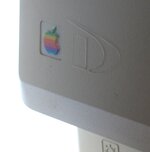The cattle-stamping was done in house at Drexel, this was discussed here or someplace (maybe FaceBook) many years ago when I bought my first Drexel Mac. There was an extensive thread about them too with photos showing Drexel Macs on the production line and being delivered to students. There are other photos showing the same cattle stamped D done to PCs and other hardware like printers, etc. Not at all an uncommon practice really, even my High School branded stuff with a hot iron. The assumption is that its is very, very hard to remove. As for why the stamped the front they way they did, I think it was just to mimic what Apple did to the first 1,850 Macs with the Blue D.
The difference is the cattle-branding was only done to systems owned by the university itself, it was not done to those bought by students through the school. The Blue D versions go either way it seems. I have had four blue D Drexel's to date with my current one being once owned by a professor - it appears to be University property as it also has metal inventory stickers on the keyboard and I think even one wedged onto the mouse - would have to look, been a while. The other systems were student system and lacked asset tags. But interesting the professors Mac does not have a secondary cattle-stamp.
So yes, the cattle-branded 128ks will be less common I think since the University required students to have computers and thus probably has fewer systems themselves. Then you take into account the shorter life of the 128k. I have seen 512k and even Pluses with Drexel cattle branding, usually on the back or sides and often not well centered or leveled.
Just to add some cool info, dont want to derail this tread more! LOL
By January 1984, Drexel University had already cut its own slice of the Apple pie and was anxiously waiting to serve it on a silver platter. Rumor had it that each unit would be embossed with a blue “D” for Drexel. They would become known in the corridors of Matheson and Main as the “DUs.”
By the fall of 1983, just as Jobs addressed his troops in Waikiki, the Trek Building, located at 32nd and Race Street, had been renovated to facilitate the influx and distribution of approximately 2,000 nameless, top-secret Apple computers. A state-of-the-art computer classroom was installed in the Korman Center; a group called DUsers, comprising students with microcomputer experience, was convened to help the uninitiated. A newsletter called boot was conceived and edited by Professor Tom Hewett to address the pressing issues of the microcomputer user.
Just before the launch, a group of graduating seniors was given access to a roomful of covered computers with no visible labels. They poked around, played with the graphic user interface, saved files on strange floppy disks. Afterward, they were administered a test to assess the effects of microcomputing on stress and anxiety, stratified by age, gender and academic major. The results were clear: Drexel was ready.
And so it was that, on March 5, 1984, some three years after President Hagerty’s prophetic announcement, 1,850 Drexel freshmen trudged up 32nd Street in the cold to pick up their very own Macintosh 128K.
The rumors were true. Each computer was embossed with a blue “D” for Drexel. The price? $1,000, plus tax. Not bad for a unit that sold for $2,495 retail. The 20-pound package included MacWrite, MacPaint and Microsoft Multiplan software, designed by some nerd named Bill Gates. Each box contained the CPU, a keyboard and a mouse. At the time, some faculty had to be told that the mouse was not of the rodent persuasion, but was, rather, a device for navigation.

